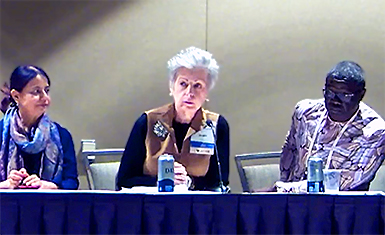Here's how capacity building leads to pandemic preparedness
November / December 2022 | Volume 21 Number 6
 Courtesy of ASTHMKaren Goraleski (middle) gives closing remarks during a panel at the 2022 ASTHM meeting. Erum Khan (left) and Christian Happi (right) were also speakers.
Courtesy of ASTHMKaren Goraleski (middle) gives closing remarks during a panel at the 2022 ASTHM meeting. Erum Khan (left) and Christian Happi (right) were also speakers.
"Research capacity is a critical element of pandemic preparedness." With these words, Fogarty Deputy Director Dr. Peter Kilmarx began a symposium at the annual meeting of the American Society of Tropical Medicine & Hygiene (ASTMH) in November. The panel was moderated by Kilmarx and Karen Goraleski, ASTMH CEO and a Fogarty board member, and featured speakers from Africa, South Asia, Latin America, and the Caribbean. Each speaker told a separate story about establishing research capacity before the pandemic at their respective institutions with support from Fogarty and other NIH institutes and how this aided their national and regional response to COVID-19. Each also proposed future priorities for capacity-strengthening programs, explaining how these might help them prepare for future pandemics and health emergencies.
Dr. Christian Happi, a Principal Investigator on Fogarty's H3 Africa program and Director of the African Centre of Excellence for Genomics of Infectious Diseases (ACEGID), highlighted how conducting genomic sequencing of Ebola during the 2014-2016 West African outbreak prepared them for COVID-19. "We realized we were years ahead of the WHO because we were trying to use genomics to guide the public health response," he said. This progressive thinking meant ACEGID, based at Redeemer's University, Nigeria, was equipped to respond to COVID and resulted in
Nigeria becoming the first on the continent to sequence the SARS-CoV-2 genome in an African patient. During the pandemic, ACEGID trained more than 1,300 scientists in 42 African countries. SENTINEL Pandemic Preemption and Response—a program set up before COVID—now has the breadth of experience to give Africa "the necessary workforce not only to address epidemics on the continent but also to help protect the world," he said.
In Pakistan, the Aga Khan University (AKU) was able to mobilize research scientists trained in whole genome sequencing of diseases like dengue, West Nile Virus, and tuberculosis to aid in the government's response to the pandemic, said Dr. Erum Khan, Professor in Microbiology at AKU Hospital. She noted, "If we hadn't been able to move people from the research side [of the university] to the clinical side, it would not have been possible to identify COVID variants and run diagnostics" at the pace of up to 2,000 cases per day. "The most important lesson we learned was the speed at which we can spot the emerging pathogen and limit the spread of it. The only way we can do this is at the global level," Khan added, emphasizing that sharing resources in addition to knowledge is key for many low-resource settings.
In some cases, the pandemic helped expand institutional resources. For example, the Jamaican Ministry of Health reached out to Dr. John Lindo's research laboratory at University of the West Indies (UWI), which, through a
Fogarty-funded partnership with the State University of New York (SUNY) at Buffalo, had set up a program focused on emerging and chronic viral infections. The ministry wanted to use next-generation sequencing for COVID surveillance and so enabled UWI to set up a genomic center at the university. Prior to that, Lindo explained, "we'd have to send samples to Trinidad and wait quite a while for those results," something not practical in the middle of a pandemic.
Before COVID, the Centro Internacional de Entrenamiento e Investigaciones Médicas (CIDEIM) in Colombia, did not focus on virology at all but on diseases like malaria, leishmaniasis, and syphilis. Yet their "know-how in diagnostic tests"—some of it developed via their
Fogarty-funded training program focusing on emerging infectious diseases—allowed them to lend support for case identification and validation, according to Dr. Nancy Gore Saravia, director of CIDEIM. The multidisciplinary approach they had developed in other transmissible diseases was a kind of “card of introduction" for the center to participate in the NIH of Colombia's response. Afterwards, based on this COVID work, they received an NIH grant to build infrastructure including a Biosafety Level 3 (BSL-3) lab, something the center previously lacked.
Finally, Dr. Sikhulile Moyo discussed how studying HIV viral evolution prepared him for COVID. The former Fogarty Fellow and current Laboratory Director at the Botswana-Harvard AIDS Institute Partnership said that having built systems and networks in response to HIV/AIDS over the years allowed his team in Botswana to pivot and establish systematic pathogen surveillance early in the pandemic. This was critical for identifying and tracking variants, and eventually led to the discovery of omicron, subvariants of which account for most of the current infections globally. Still, he knows the challenges low- and middle-income countries like his own face in the current pandemic and will most likely face in the future: "In the region where omicron was identified, I'm sure it will take months and years [for the omicron-adapted vaccine] to arrive." Moyo concluded that it is important to have African scientists "who you can look up to" and who can “push the science forward" while providing leadership to others on the continent.
More Information
- Related stories:
- Related Fogarty grants:
Updated December 15, 2022
To view Adobe PDF files,
download current, free accessible plug-ins from Adobe's website.
Related Fogarty Programs
Related Global Health Research Topics